Jinyuan Liu
FloorSAM: SAM-Guided Floorplan Reconstruction with Semantic-Geometric Fusion
Sep 19, 2025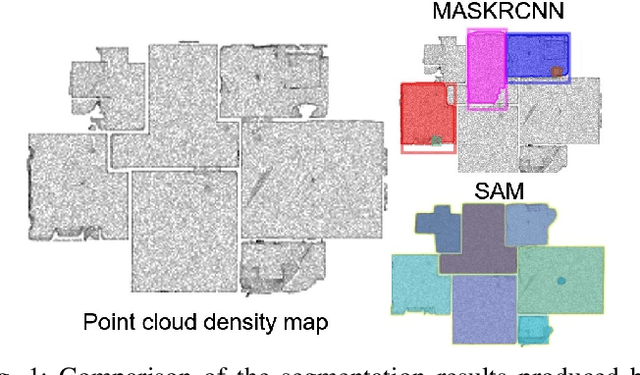
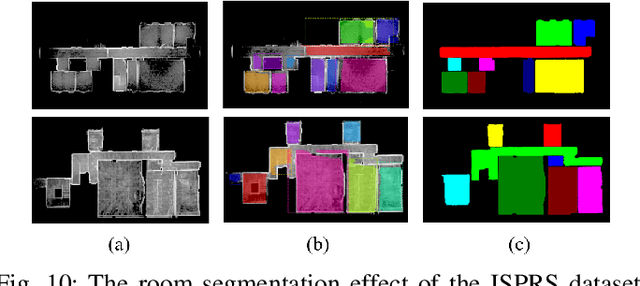
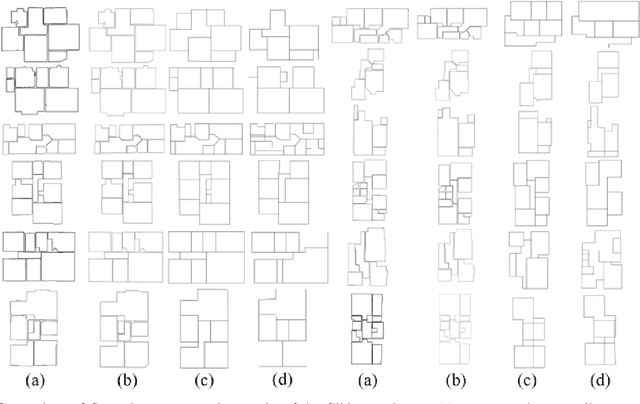
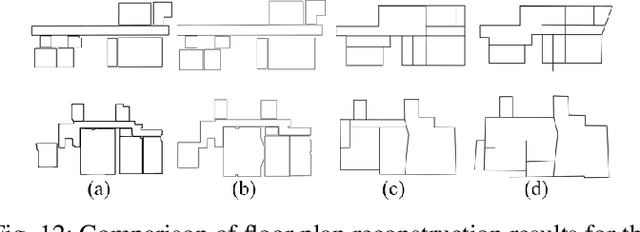
Abstract:Reconstructing building floor plans from point cloud data is key for indoor navigation, BIM, and precise measurements. Traditional methods like geometric algorithms and Mask R-CNN-based deep learning often face issues with noise, limited generalization, and loss of geometric details. We propose FloorSAM, a framework that integrates point cloud density maps with the Segment Anything Model (SAM) for accurate floor plan reconstruction from LiDAR data. Using grid-based filtering, adaptive resolution projection, and image enhancement, we create robust top-down density maps. FloorSAM uses SAM's zero-shot learning for precise room segmentation, improving reconstruction across diverse layouts. Room masks are generated via adaptive prompt points and multistage filtering, followed by joint mask and point cloud analysis for contour extraction and regularization. This produces accurate floor plans and recovers room topological relationships. Tests on Giblayout and ISPRS datasets show better accuracy, recall, and robustness than traditional methods, especially in noisy and complex settings. Code and materials: github.com/Silentbarber/FloorSAM.
A Knowledge Noise Mitigation Framework for Knowledge-based Visual Question Answering
Sep 11, 2025Abstract:Knowledge-based visual question answering (KB-VQA) requires a model to understand images and utilize external knowledge to provide accurate answers. Existing approaches often directly augment models with retrieved information from knowledge sources while ignoring substantial knowledge redundancy, which introduces noise into the answering process. To address this, we propose a training-free framework with knowledge focusing for KB-VQA, that mitigates the impact of noise by enhancing knowledge relevance and reducing redundancy. First, for knowledge retrieval, our framework concludes essential parts from the image-question pairs, creating low-noise queries that enhance the retrieval of highly relevant knowledge. Considering that redundancy still persists in the retrieved knowledge, we then prompt large models to identify and extract answer-beneficial segments from knowledge. In addition, we introduce a selective knowledge integration strategy, allowing the model to incorporate knowledge only when it lacks confidence in answering the question, thereby mitigating the influence of redundant information. Our framework enables the acquisition of accurate and critical knowledge, and extensive experiments demonstrate that it outperforms state-of-the-art methods.
A Fast Method for Planning All Optimal Homotopic Configurations for Tethered Robots and Its Extended Applications
Jul 16, 2025Abstract:Tethered robots play a pivotal role in specialized environments such as disaster response and underground exploration, where their stable power supply and reliable communication offer unparalleled advantages. However, their motion planning is severely constrained by tether length limitations and entanglement risks, posing significant challenges to achieving optimal path planning. To address these challenges, this study introduces CDT-TCS (Convex Dissection Topology-based Tethered Configuration Search), a novel algorithm that leverages CDT Encoding as a homotopy invariant to represent topological states of paths. By integrating algebraic topology with geometric optimization, CDT-TCS efficiently computes the complete set of optimal feasible configurations for tethered robots at all positions in 2D environments through a single computation. Building on this foundation, we further propose three application-specific algorithms: i) CDT-TPP for optimal tethered path planning, ii) CDT-TMV for multi-goal visiting with tether constraints, iii) CDT-UTPP for distance-optimal path planning of untethered robots. All theoretical results and propositions underlying these algorithms are rigorously proven and thoroughly discussed in this paper. Extensive simulations demonstrate that the proposed algorithms significantly outperform state-of-the-art methods in their respective problem domains. Furthermore, real-world experiments on robotic platforms validate the practicality and engineering value of the proposed framework.
Robust Beamforming Design for STAR-RIS Aided RSMA Network with Hardware Impairments
May 13, 2025Abstract:In this article, we investigate the robust beamforming design for a simultaneous transmitting and reflecting reconfigurable intelligent surface (STAR-RIS) aided downlink rate-splitting multiple access (RSMA) communication system, where both transceivers and STAR-RIS suffer from the impact of hardware impairments (HWI). A base station (BS) is deployed to transmit messages concurrently to multiple users, utilizing a STAR-RIS to improve communication quality and expand user coverage. We aim to maximize the achievable sum rate of the users while ensuring the constraints of transmit power, STAR-RIS coefficients, and the actual rate of the common stream for all users. To solve this challenging high-coupling and non-convexity problem, we adopt a fractional programming (FP)-based alternating optimization (AO) approach, where each sub-problem is addressed via semidefinite relaxation (SDR) and successive convex approximation (SCA) methods. Numerical results demonstrate that the proposed scheme outperforms other multiple access schemes and conventional passive RIS in terms of the achievable sum rate. Additionally, considering the HWI of the transceiver and STAR-RIS makes our algorithm more robust than when such considerations are not included.
CoA: Towards Real Image Dehazing via Compression-and-Adaptation
Apr 08, 2025Abstract:Learning-based image dehazing algorithms have shown remarkable success in synthetic domains. However, real image dehazing is still in suspense due to computational resource constraints and the diversity of real-world scenes. Therefore, there is an urgent need for an algorithm that excels in both efficiency and adaptability to address real image dehazing effectively. This work proposes a Compression-and-Adaptation (CoA) computational flow to tackle these challenges from a divide-and-conquer perspective. First, model compression is performed in the synthetic domain to develop a compact dehazing parameter space, satisfying efficiency demands. Then, a bilevel adaptation in the real domain is introduced to be fearless in unknown real environments by aggregating the synthetic dehazing capabilities during the learning process. Leveraging a succinct design free from additional constraints, our CoA exhibits domain-irrelevant stability and model-agnostic flexibility, effectively bridging the model chasm between synthetic and real domains to further improve its practical utility. Extensive evaluations and analyses underscore the approach's superiority and effectiveness. The code is publicly available at https://github.com/fyxnl/COA.
DifIISR: A Diffusion Model with Gradient Guidance for Infrared Image Super-Resolution
Mar 03, 2025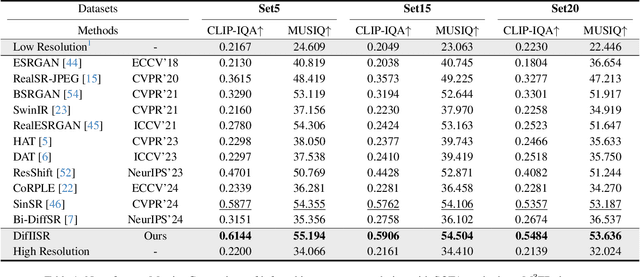
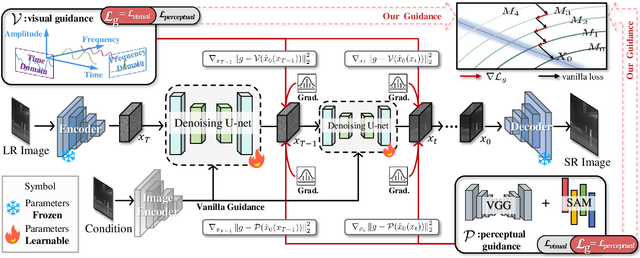

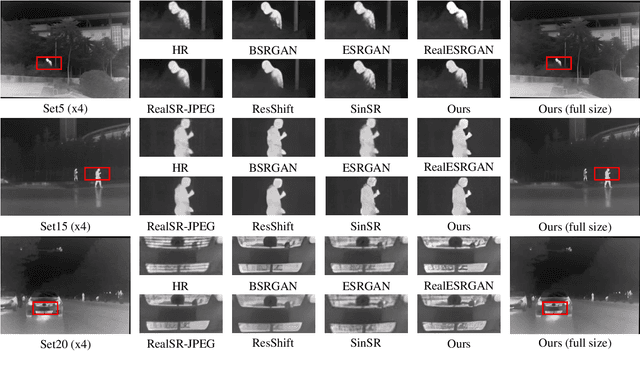
Abstract:Infrared imaging is essential for autonomous driving and robotic operations as a supportive modality due to its reliable performance in challenging environments. Despite its popularity, the limitations of infrared cameras, such as low spatial resolution and complex degradations, consistently challenge imaging quality and subsequent visual tasks. Hence, infrared image super-resolution (IISR) has been developed to address this challenge. While recent developments in diffusion models have greatly advanced this field, current methods to solve it either ignore the unique modal characteristics of infrared imaging or overlook the machine perception requirements. To bridge these gaps, we propose DifIISR, an infrared image super-resolution diffusion model optimized for visual quality and perceptual performance. Our approach achieves task-based guidance for diffusion by injecting gradients derived from visual and perceptual priors into the noise during the reverse process. Specifically, we introduce an infrared thermal spectrum distribution regulation to preserve visual fidelity, ensuring that the reconstructed infrared images closely align with high-resolution images by matching their frequency components. Subsequently, we incorporate various visual foundational models as the perceptual guidance for downstream visual tasks, infusing generalizable perceptual features beneficial for detection and segmentation. As a result, our approach gains superior visual results while attaining State-Of-The-Art downstream task performance. Code is available at https://github.com/zirui0625/DifIISR
Every SAM Drop Counts: Embracing Semantic Priors for Multi-Modality Image Fusion and Beyond
Mar 03, 2025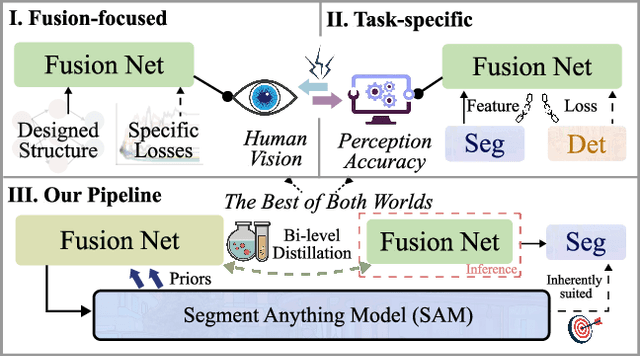
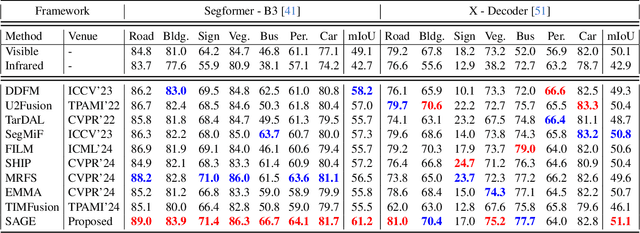
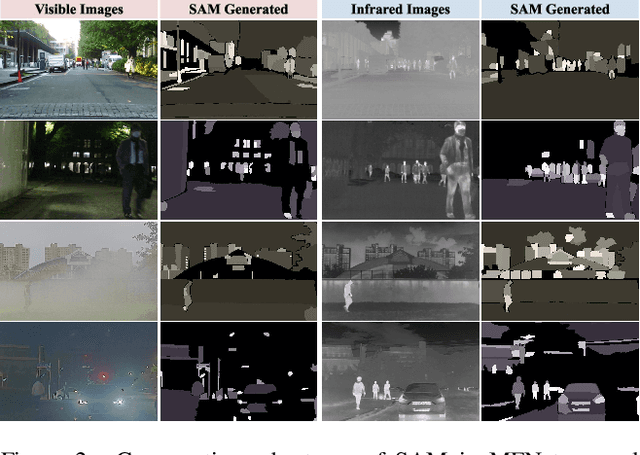
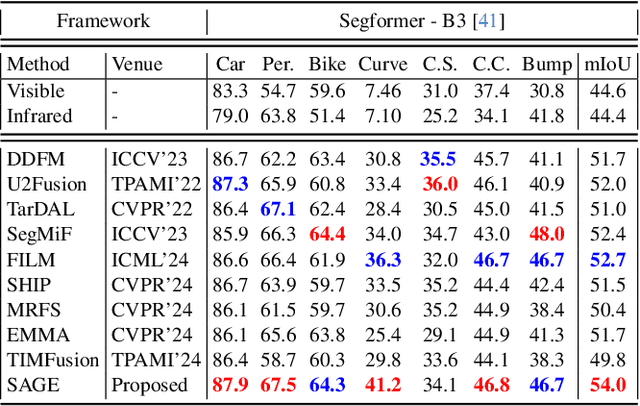
Abstract:Multi-modality image fusion, particularly infrared and visible image fusion, plays a crucial role in integrating diverse modalities to enhance scene understanding. Early research primarily focused on visual quality, yet challenges remain in preserving fine details, making it difficult to adapt to subsequent tasks. Recent approaches have shifted towards task-specific design, but struggle to achieve the ``The Best of Both Worlds'' due to inconsistent optimization goals. To address these issues, we propose a novel method that leverages the semantic knowledge from the Segment Anything Model (SAM) to Grow the quality of fusion results and Establish downstream task adaptability, namely SAGE. Specifically, we design a Semantic Persistent Attention (SPA) Module that efficiently maintains source information via the persistent repository while extracting high-level semantic priors from SAM. More importantly, to eliminate the impractical dependence on SAM during inference, we introduce a bi-level optimization-driven distillation mechanism with triplet losses, which allow the student network to effectively extract knowledge at the feature, pixel, and contrastive semantic levels, thereby removing reliance on the cumbersome SAM model. Extensive experiments show that our method achieves a balance between high-quality visual results and downstream task adaptability while maintaining practical deployment efficiency.
DEAL: Data-Efficient Adversarial Learning for High-Quality Infrared Imaging
Mar 02, 2025

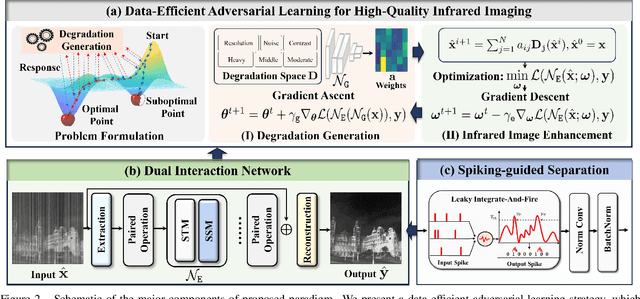

Abstract:Thermal imaging is often compromised by dynamic, complex degradations caused by hardware limitations and unpredictable environmental factors. The scarcity of high-quality infrared data, coupled with the challenges of dynamic, intricate degradations, makes it difficult to recover details using existing methods. In this paper, we introduce thermal degradation simulation integrated into the training process via a mini-max optimization, by modeling these degraded factors as adversarial attacks on thermal images. The simulation is dynamic to maximize objective functions, thus capturing a broad spectrum of degraded data distributions. This approach enables training with limited data, thereby improving model performance.Additionally, we introduce a dual-interaction network that combines the benefits of spiking neural networks with scale transformation to capture degraded features with sharp spike signal intensities. This architecture ensures compact model parameters while preserving efficient feature representation. Extensive experiments demonstrate that our method not only achieves superior visual quality under diverse single and composited degradation, but also delivers a significant reduction in processing when trained on only fifty clear images, outperforming existing techniques in efficiency and accuracy. The source code will be available at https://github.com/LiuZhu-CV/DEAL.
Infrared and Visible Image Fusion: From Data Compatibility to Task Adaption
Jan 18, 2025Abstract:Infrared-visible image fusion (IVIF) is a critical task in computer vision, aimed at integrating the unique features of both infrared and visible spectra into a unified representation. Since 2018, the field has entered the deep learning era, with an increasing variety of approaches introducing a range of networks and loss functions to enhance visual performance. However, challenges such as data compatibility, perception accuracy, and efficiency remain. Unfortunately, there is a lack of recent comprehensive surveys that address this rapidly expanding domain. This paper fills that gap by providing a thorough survey covering a broad range of topics. We introduce a multi-dimensional framework to elucidate common learning-based IVIF methods, from visual enhancement strategies to data compatibility and task adaptability. We also present a detailed analysis of these approaches, accompanied by a lookup table clarifying their core ideas. Furthermore, we summarize performance comparisons, both quantitatively and qualitatively, focusing on registration, fusion, and subsequent high-level tasks. Beyond technical analysis, we discuss potential future directions and open issues in this area. For further details, visit our GitHub repository: https://github.com/RollingPlain/IVIF_ZOO.
A2RNet: Adversarial Attack Resilient Network for Robust Infrared and Visible Image Fusion
Dec 18, 2024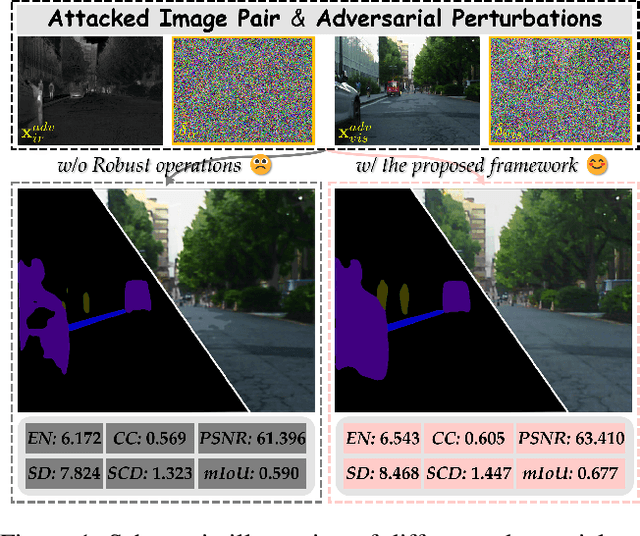


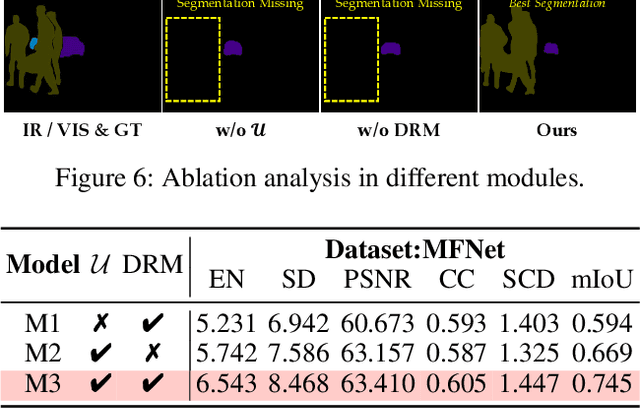
Abstract:Infrared and visible image fusion (IVIF) is a crucial technique for enhancing visual performance by integrating unique information from different modalities into one fused image. Exiting methods pay more attention to conducting fusion with undisturbed data, while overlooking the impact of deliberate interference on the effectiveness of fusion results. To investigate the robustness of fusion models, in this paper, we propose a novel adversarial attack resilient network, called $\textrm{A}^{\textrm{2}}$RNet. Specifically, we develop an adversarial paradigm with an anti-attack loss function to implement adversarial attacks and training. It is constructed based on the intrinsic nature of IVIF and provide a robust foundation for future research advancements. We adopt a Unet as the pipeline with a transformer-based defensive refinement module (DRM) under this paradigm, which guarantees fused image quality in a robust coarse-to-fine manner. Compared to previous works, our method mitigates the adverse effects of adversarial perturbations, consistently maintaining high-fidelity fusion results. Furthermore, the performance of downstream tasks can also be well maintained under adversarial attacks. Code is available at https://github.com/lok-18/A2RNet.
 Add to Chrome
Add to Chrome Add to Firefox
Add to Firefox Add to Edge
Add to Edge